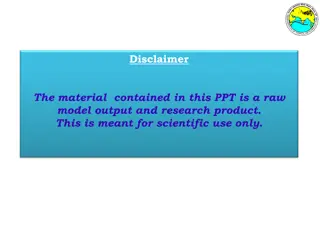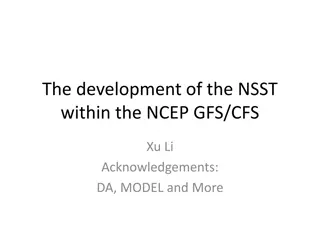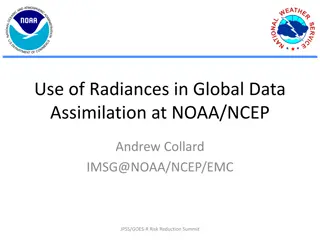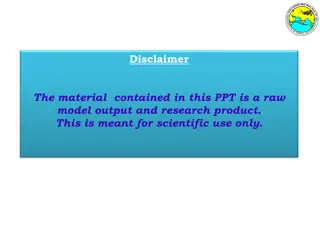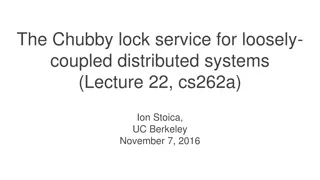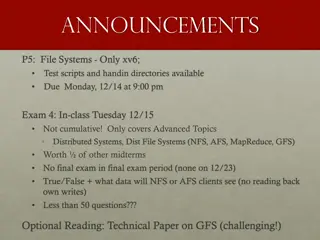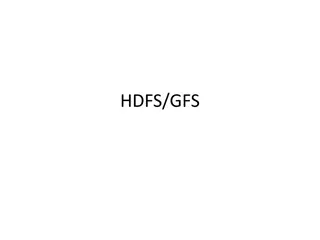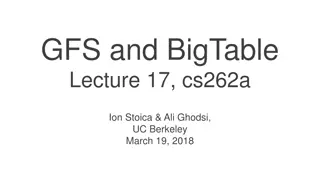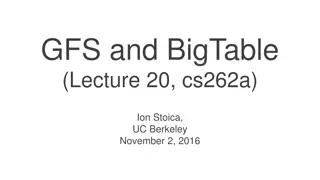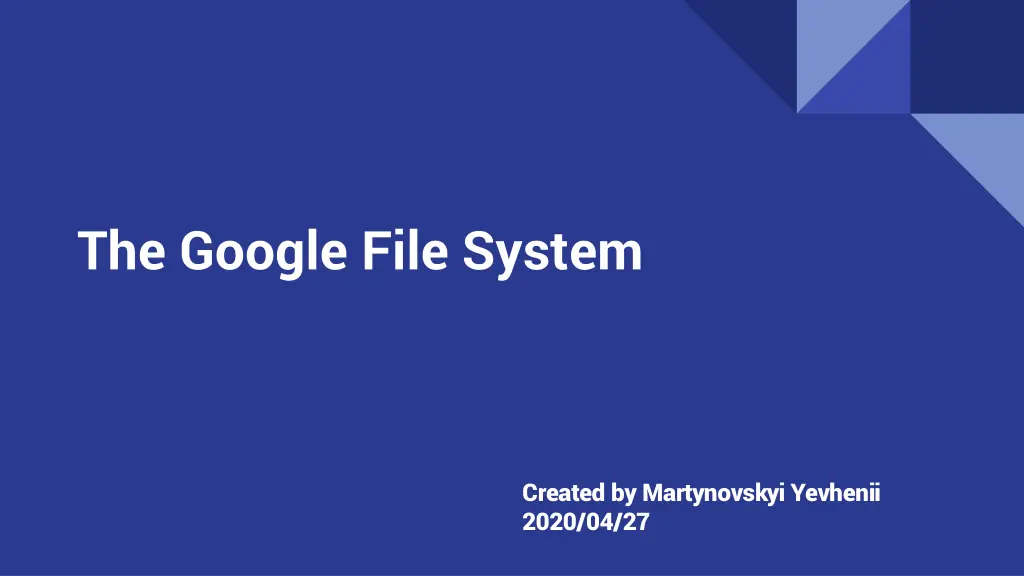
Google File System Overview
"Explore the architecture and design of the Google File System (GFS), focusing on its unique features such as massive storage, co-design with applications, relaxed consistency model, and more. Learn how GFS tackles challenges in performance, scalability, reliability, and availability to support highly distributed applications effectively."
Download Presentation

Please find below an Image/Link to download the presentation.
The content on the website is provided AS IS for your information and personal use only. It may not be sold, licensed, or shared on other websites without obtaining consent from the author. If you encounter any issues during the download, it is possible that the publisher has removed the file from their server.
You are allowed to download the files provided on this website for personal or commercial use, subject to the condition that they are used lawfully. All files are the property of their respective owners.
The content on the website is provided AS IS for your information and personal use only. It may not be sold, licensed, or shared on other websites without obtaining consent from the author.
E N D
Presentation Transcript
The Google File System Created by Martynovskyi Yevhenii 2020/04/27
Content Introduction Overview System Algorithms and tests Results Conclusion
Introduction Google File System (GFS) shares many of the same goals as previous distributed file systems such as: performance,scalability, reliability, and availability. However, its design has been driven by key observations of our application work-loads and technological environment, both current and anticipated, that reflect a marked departure from some earlier file system design assumptions.
Introduction First:The file system consists of hundreds or even thousands of storage machines built from inexpensive commodity parts and is accessed by a comparable number of client machines. Second: files are huge by traditional standards. Multi GB files are common. Each file typically contains many application objects such as web documents. Third: most files are mutated by appending new data rather than overwriting existing data. Random writes within a file are practically non- existent. Once written, the files are only read, and often only sequentially. Fourth: co-designing the applications and the file system API benefits the overall system by increasing our flexibility.
Overview GFSInterface and design: provides a familiar file system interface, though it does not implement a standard API such as POSIX. Files are organized hierarchically in directories and identified by path-names.
Overview GFS Architecture: GFS cluster consists of a single master and multiple chunk servers and is accessed by multiple clients. Each of these is typically a commodity Linux machine running a user-level server process.
Overview Consistency Model GFS has a relaxed consistency model that supports our highly distributed applications well but remains relatively simple and efficient to implement. Guarantees by GFS File namespace mutations (e.g., file creation) are atomic.They are handled exclusively by the master: namespace locking guarantees atomicity and correctness the master s operation log defines a global total order of these operations. The state of a file region after a data mutation depends on the type of mutation, whether it succeeds or fails, and whether there are concurrent mutations. Since clients cache chunk locations, they may read from astale replica before that information is refreshed. Long after a successful mutation, component failures can of course still corrupt or destroy data. GFS identifies failed chunk servers by regular handshakes between master and all chunk servers and detects data corruption by checksumming.
System The master may sometimes try to revoke a lease before it expires. Even if the master loses communication with a primary, it can safely grant a new lease to another replica after the old lease expires. The master executes all namespace operations. In addition, it manages chunk replicas throughout the system: it makes placement decisions, creates new chunks and hence replicas, and coordinates various system-wide activities to keep chunks fully replicated, to balance load across all the chunk servers, and to reclaim unused storage
System Both the master and the chunkserver are designed to restore their state and start in seconds no matter how they terminated. In fact, we do not distinguish between normal and abnormal termination; servers are routinely shut down just by killing the process. Clients and other servers experience a minor hiccup as they time out on their outstanding requests, reconnect to the restarted server, and retry.
Algorithms and tests Cluster A is used regularly for research and development by over a hundred engineers. A typical task is initiated by a human user and runs up to several hours. Cluster B is primarily used for production data processing. In both cases,a single task consists of many processes on many machines reading and writing many files simultaneously.
Workload Breakdown Write sizes also exhibit a bimodal distribution. The large writes (over 256 KB) typically result from significant buffer-ing within the writers. Writers that buffer less data, check-point or synchronize more often, or simply generate less data account for the smaller writes (under 64 KB).(Table4) As for record appends, cluster Y sees a much higher percentage of large record appends than cluster X does because our production systems, which use cluster Y, are more aggressively tuned for GFS.(Table 5)
Conclusions The Google File System demonstrates the qualities essential for supporting large scale data processing workloads on commodity hardware. While some design decisions are specific to unique settings, many may apply to data processing tasks of a similar magnitude and cost consciousness. GFS has successfully met our storage needs and is widely used within Google as the storage platform for research and development as well as production data processing. It is an important tool that enables us to continue to innovate and attack problems on the scale of the entire web.
REFERENCES [1]Frank Schmuck and Roger Has kin. GPFS: A shared-disk file system for large computing clusters. In Proceedings of the First USENIX Conference on File and Storage Technologies, pages 231 244, Monterey,California, January 2002. [2]Lustre. http://www.lustreorg, 2003 [3]Sanjay Ghemawat et al., The Google File System, SOSP, 2003


